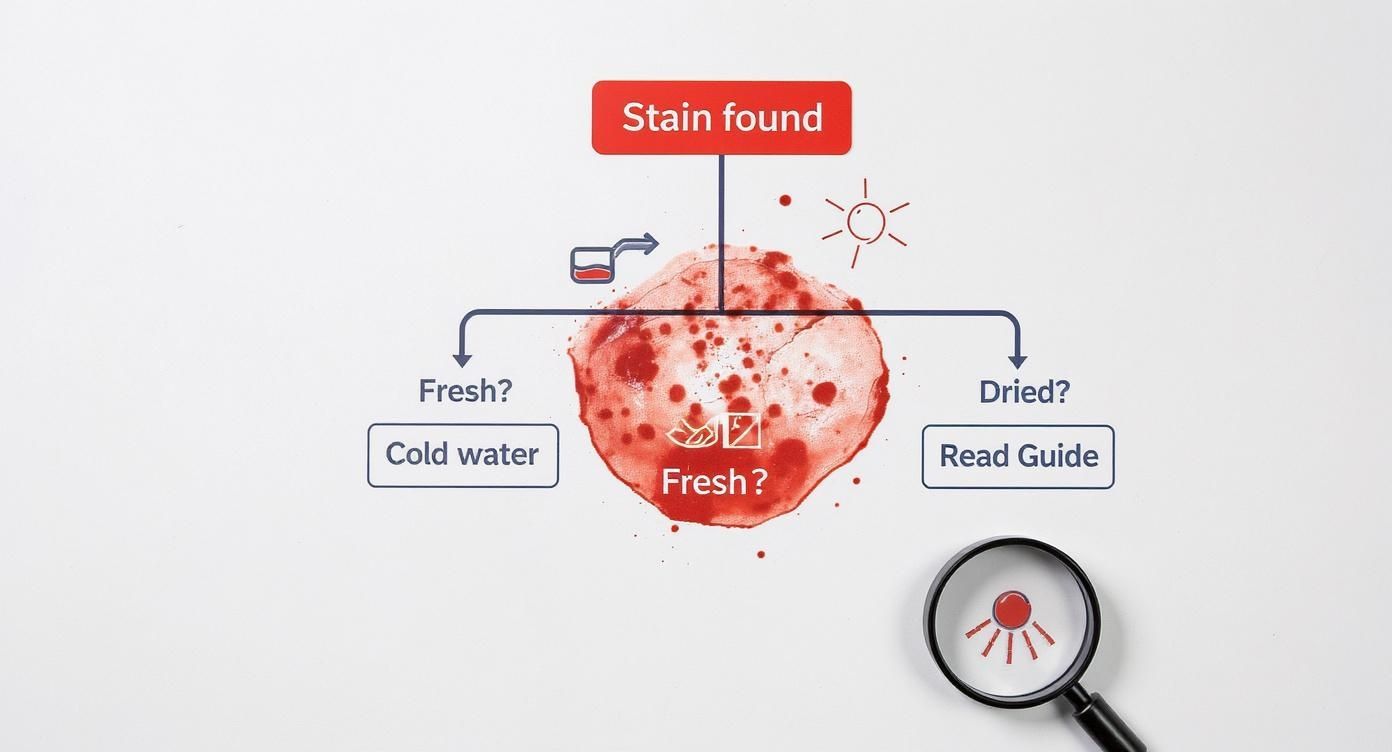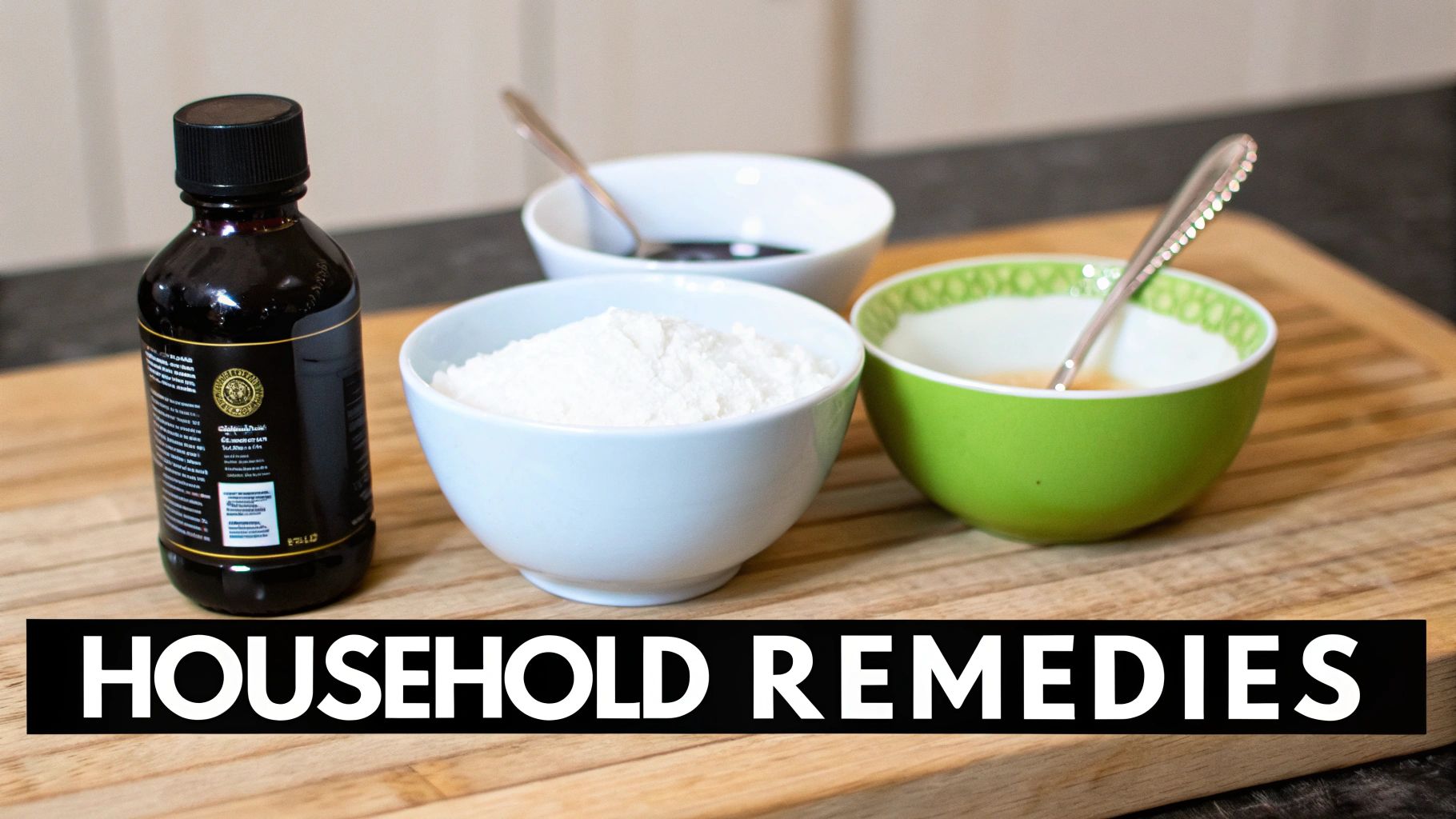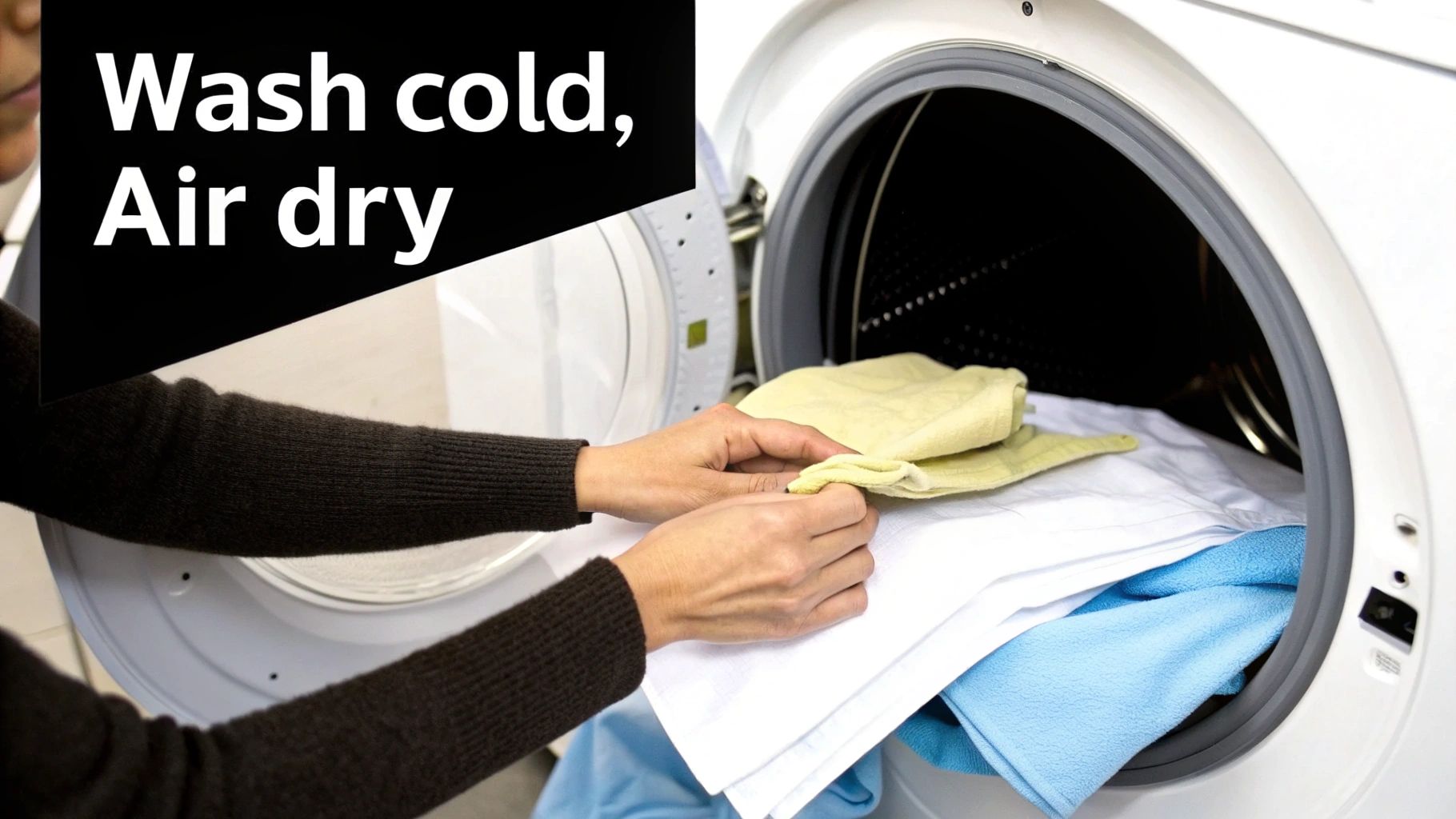Woke up to an unexpected blood stain on your sheets? Don't panic. Whether it's from a small cut or a nosebleed, knowing how to remove blood from bed sheets is simple when you act fast and, most importantly, use the right temperature. The single most important rule is to always use cold water, as heat will permanently set the stain. This guide gives you the essential steps to make your bedding look new again.
First Steps: What to Do Immediately
What you do in the first few minutes after spotting a blood stain makes all the difference. Get it right, and it's a simple clean-up. A common mistake, like using hot water, can literally "cook" the blood's proteins, binding them to the fabric fibres and creating a permanent mark.
Instead, your first move should be to flush the area with cold water from the back of the stain. This pushes the blood out of the fabric, rather than forcing it deeper. Research shows that immediate cold water flushing, followed by an effective pre-treatment, can successfully remove over 85% of fresh stains.
This infographic lays out a quick visual guide for the moment you spot a stain.

As you can see, the first question is always whether the stain is fresh. If it is, cold water is your most powerful tool.
Your Immediate Action Plan
Acting quickly is vital, but so is acting correctly. These simple techniques will protect your bedding and set you up for a successful removal.
| Action (Do This) | Mistake (Avoid This) |
|---|---|
| Immediately flush with cold water from the back. | Never use hot or even warm water initially. |
| Blot the stain gently with a clean, damp cloth. | Don't rub or scrub the stain. |
| Work from the outside edge of the stain inwards. | Avoid spreading the stain by starting in the middle. |
| Act as quickly as possible to prevent setting. | Don't let the stain sit and dry out. |
Practical Example: Imagine a small nosebleed stain. Instead of rubbing it, take the sheet to the sink, turn it over, and let cold tap water run through the back of the fabric. You'll see the stain start to fade instantly as the water pushes the blood out.
A few extra pointers to keep in mind:
- Blot, Don't Rub: Gently blot the stain with a clean, damp cloth or paper towel. Your goal is to lift excess blood off the surface. Rubbing just spreads the stain and pushes it deeper into the fabric's weave.
- Work from the Outside In: Always start blotting at the outer edges of the stain and work toward the centre. This clever trick contains the stain and stops you from accidentally making it bigger.
While we're talking about sheets, these principles apply to other materials too. The initial steps are quite similar if you need to learn how to get blood out of carpet.
How to Remove Blood from Bed Sheets Using Household Items

Once you've rinsed the stain with cold water, there’s no need to reach for harsh chemicals. Your kitchen pantry likely has everything you need to get blood out of your bed sheets. Common ingredients like salt, white vinegar, and baking soda are surprisingly effective against stubborn protein stains. Salt acts as a natural dehydrating agent, pulling moisture and blood out of the fibres, while the mild acidity of vinegar helps break down proteins.
Create a Targeted Baking Soda Paste
For smaller, concentrated stains, a baking soda paste is your best bet. It lets you treat the exact spot without drenching the entire sheet.
- Mix: Stir together two parts baking soda with one part cold water to form a thick, spreadable paste.
- Apply: Gently cover the entire stain with the paste.
- Wait: Let it sit for at least 30 minutes, or until the paste is completely dry. As it dries, the baking soda lifts the stain from the fabric.
- Remove: Scrape off the dried paste and rinse the area thoroughly with cold water before washing.
This gentle method is a brilliant trick that shows you don't need expensive stain removers.
Use a Salt or Vinegar Soak for Larger Areas
If you're dealing with a larger stain, a pre-soak is more effective than spot treatment. Both salt and white vinegar make excellent soaking solutions.
For a salt soak, dissolve a generous amount of table salt in a tub of cold water, submerge the stained section, and let it soak for a few hours.
Alternatively, try a vinegar soak by mixing one part white vinegar with two parts cold water. This approach is great for tackling the stain and can also help neutralise any lingering odours. Just remember to rinse the sheet well before it goes into the machine. While giving your sheets attention, you might want to refresh other items too; our guide on how to wash a pillow has some fantastic tips.
How to Tackle Stubborn and Dried Blood Stains
Discovering an old, dried blood stain can be disheartening, but it's not a lost cause. Getting dried blood out of sheets is entirely possible with the right approach. Your secret weapon here is an enzymatic cleaner.
Dried blood is tough because its proteins have had time to latch onto the fabric fibres. Enzymatic cleaners contain enzymes like protease, which specifically target and dissolve protein-based stains (like blood), making them easier to wash away.
The Power of a Long Soak
For a set-in stain, a simple dab of cleaner won't be enough. You need to give the product time to penetrate and break down the stain. A pre-soak is your best bet for stubborn marks.
Here’s the right way to do it:
- Choose Your Product: Look for a laundry soaker or stain remover that specifically lists enzymes on the label.
- Prepare the Soak: Fill a tub or basin with cold water. Never use warm or hot water, as it will set the stain deeper.
- Add the Cleaner: Follow the package instructions to mix the recommended amount of enzymatic cleaner into the water.
- Soak Patiently: Submerge the stained part of the sheet. For a tough stain, soak it for at least a few hours, or even overnight. This gives the enzymes plenty of time to work.
This soaking method is also fantastic for a deep clean on larger items. If you want to refresh more of your bedding, our guide on how to wash and care for down quilts uses similar principles.
Proven Products That Really Work
When browsing the laundry aisle, look for products containing sodium percarbonate, often marketed as an "oxygen-based bleach" or "oxi-action" cleaner. It's brilliant for lifting dried organic stains without the harshness of traditional chlorine bleach.
A scientific study found that a household stain remover with sodium percarbonate was highly effective at visibly reducing dried blood stains. You can even read the full research about these findings if you're curious. After a successful soak, simply run the sheets through a final cold wash cycle.
The Final Wash: Getting Your Sheets Spotless

After pre-treating the stain, the final wash brings it all together. It’s tempting to use a hot cycle, but this is the worst thing you can do. Heat will cook any remaining blood proteins into the fibres, setting the stain for good.
Always choose a cold water wash. Pair this with a good quality, enzyme-based laundry detergent, which will continue to break down any last traces of the stain. This gentle but effective approach works for all kinds of sheets. For specific materials, find tailored advice in our guide on how to wash bamboo sheets.
The Crucial Post-Wash Check
Before you even think about the dryer, this next step is essential. Inspect the sheet while it’s still wet to make sure the stain is completely gone.
Hold the area up to a bright light. If you see even a faint shadow, it’s not ready for the dryer. The intense heat from a tumble dryer will act like an iron, permanently setting any remaining mark.
Spotted a lingering mark? Don't worry. Simply repeat your chosen pre-treatment method and run the sheets through another cold wash. Only when you’re 100% certain the stain has vanished should you dry them. Line drying is ideal, but a low-heat tumble dry also works.
Caring for Different Bedding Fabrics
Not all bed sheets can be treated the same. What works for sturdy cotton could ruin delicate silk. Knowing your fabric is the secret to successfully getting blood out of your bedding without causing damage. For example, hydrogen peroxide might work on tough cotton but can weaken the fibres of softer materials like bamboo.
A Fabric-Specific Guide
Durable fabrics can handle stronger treatments, while delicate materials need a much softer touch. Classic cotton and linen sheets respond well to baking soda or an enzymatic cleaner. If you have beautiful linen bedding, get the care right with our specific guide on how to wash linen.
For silk and satin, you must be extra careful. Avoid enzymatic cleaners and hydrogen peroxide entirely, as they can dissolve the delicate protein fibres. Your best bet is a mild mix of cold water and a few drops of pH-neutral soap.
Here's a quick cheat sheet for common bed sheet types.
| Fabric Type | Recommended Method | What to Avoid |
|---|---|---|
| Cotton | Baking soda paste, enzymatic cleaner | Harsh chlorine bleach |
| Linen | Salt soak, gentle laundry soaker | Aggressive scrubbing |
| Bamboo | Mild soap, diluted white vinegar | High heat, strong chemicals |
| Silk/Satin | pH-neutral soap, cold water dab | Hydrogen peroxide, enzymes, heat |
Remember to always spot-test any cleaning solution on a small, hidden part of the fabric first. Understanding the general cleaning frequency for textiles can also help keep your bedding in great shape.
Frequently Asked Questions
Even with a solid plan, a few questions often pop up. Let's tackle the most common ones.
Can I Use Bleach on My White Sheets?
It's tempting, but please don't! Regular chlorine bleach can react with the proteins in blood, causing the stain to set and turn yellow. It’s also harsh on fabric fibres. Instead, use an oxygen-based bleach (an "oxi" cleaner) or an enzymatic soaker, which are designed to break down protein stains without causing damage.
What’s the Best Way to Treat Coloured Sheets?
With coloured sheets, the goal is to protect the dye. Always spot-test any product on a hidden area first. Gentle methods like a salt water soak or a commercial stain remover made for coloured fabrics are your best choices. And remember: always use cold water.
What if I Get a Stain on My Mattress Protector?
Mattress protectors are often too bulky to soak, so spot-treating is the way to go. Mix a thick paste of baking soda and cold water, apply it to the stain, and let it dry completely. Scrape off the residue and blot the area with a clean, damp cloth. Let the protector air dry completely before putting it back on the bed.
Conclusion
Removing blood from bed sheets doesn't have to be a stressful task. By acting quickly, using cold water, and choosing the right method for your fabric type, you can effectively treat even stubborn stains. From simple household solutions like baking soda to powerful enzymatic cleaners, the right tools will restore your bedding to its pristine condition.
At Sienna Living, we believe beautiful bedding deserves the best care. For more cleaning tips and to explore our collection of luxurious, easy-care sheets, check out our complete Stain Removal Hub or visit us at https://www.siennaliving.com.au to find your perfect set.

